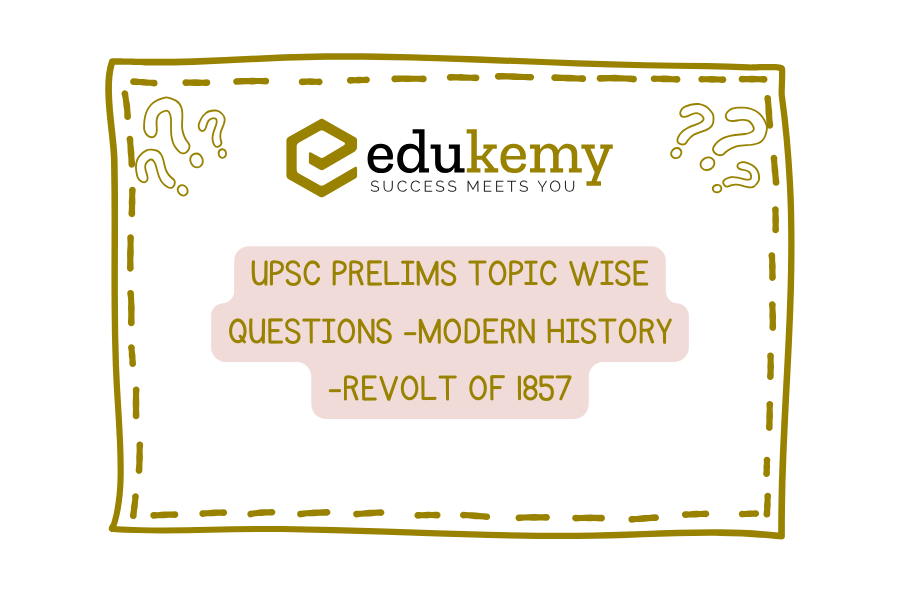Contents
- 1 1. ‘In this instance we could not play off the Mohammedans against the Hindus.’ To which one of the following events did this remark of Aitchison relate? (2000)
- 2 2. The last major extension of British Indian territory took place during the time of (2000)
- 3 3. Which one of the following places did Kunwar Singh, a prominent leader of the Revolt of 1857 belong to? (2005)
- 4 4. Which one of the following territories was not affected by the Revolt of 1857? (2005)
- 5 4. With reference to the ‘Revolt of the year’ 1857 which of the following was betrayed by friend captured and put to death by the British? (2006)
- 6 5. Who was the Governor-General of India during the Sepoy Mutiny? (2006)
- 7 6. What was/were the object/objects of Queen Victoria’s Proclamation (1858)? (2014)
1. ‘In this instance we could not play off the Mohammedans against the Hindus.’ To which one of the following events did this remark of Aitchison relate? (2000)
(a) Revolt of 1857
(b) Champaran Satyagraha (1917)
(c) Khilafat and Non-Cooperation Movement (1919-22)
(d) August Movement of 1942
Ans. (a)
- Exp. ‘In this instance we could not play off the Mohammedans against the Hindus’. This remark of Aitchison is related to the Revolt of 1857. The Indian Revolt of 1857 is also called the Indian Mutiny, the Sepoy Mutiny, India’s First War of Independence or First Struggle for Independence. The revolt began in the city of Meerut on 10th May, 1857 as a mutiny of sepoys in the British East India Company’s army.
2. The last major extension of British Indian territory took place during the time of (2000)
(a) Dufferin
(b) Dalhousie
(c) Lytton
(d) Curzon
Ans. (b)
- Exp. The last major extension of British Indian territory took place during the time of Dalhousie. Under the Doctrine of Lapse, Dalhousie annexed Satara Jaitpur and Sambalpur in 1849, Udaipur in 1852 Jhansi and Nagpur in 1853 and Awadh on the basis of misgovernance. Lord Dalhousie served as a Governor-General of India from 1848 to 1856. During this period, the Second Anglo-Sikh War (1849) was fought in which Sikhs were defeated and Dalhousie was successful in annexing the whole of Punjab to the British administration.
3. Which one of the following places did Kunwar Singh, a prominent leader of the Revolt of 1857 belong to? (2005)
(a) Bihar
(c) Rajasthan
(b) Madhya Pradesh
(d) Uttar Pradesh
Ans. (a)
- Exp. Veer Kunwar Singh who was a prominent leader of the Revolt of 1857 belonged to Bihar. He was a military commander during the Indian Rebellion of 1857 and was from a family of the Ujjaniya clan of the Parmar Rajputs of Jagdishpur, currently a part of Bhojpur district, Bihar. At the age of 80, he led a selected band of armed soldiers against the troops under the command of the British East India Company. He was the chief organizer of the fight against the British in Bihar.
4. Which one of the following territories was not affected by the Revolt of 1857? (2005)
(a) Jhansi
(b) Chittor
(c) Jagdishpur
(d) Lucknow
Ans. (b)
- Exp. Chittor was the territory not affected by the Revolt of 1857. Chittor was either neutral or were supporting the British. The areas most affected were Jhansi, Jagdishpur and Lucknow which were the prominent hotbeds of the revolt of 1857.
4. With reference to the ‘Revolt of the year’ 1857 which of the following was betrayed by friend captured and put to death by the British? (2006)
(a) Nana Sahib
(b) Kunwar Singh
(c) Khan Bahadur Khan
(d) Tantia Tope
Ans. (d)
- Exp. With reference to the ‘Revolt of the year’ 1857, Tantia Tope was betrayed by Mansingh, captured and put to death by the British. Mansingh, Raja of Narwar was a feudatory of Scindia of Gwalior. Scindia was not in favour of the Revolt. Mansingh, being loyal to Scindia at that time, betrayed Tantia lope. Tantia Tope was executed by the British Government at Shivpuri on 18th April, 1859.
5. Who was the Governor-General of India during the Sepoy Mutiny? (2006)
(a) Lord Canning
(b) Lord Dalhousie
(c) Lord Hardinge
(d) Lord Lytton
Ans. (a)
- Exp. Lord Canning was the Governor-General of India during the Sepoy Mutiny. Sepoy Mutiny was India’s first attempt to gain freedom from the British. It started in Meerut (Uttar Pradesh) on 10th May, 1857. The Revolt was suppressed in 1858. Lord Canning served as India’s first Viceroy and last Governor-General. Few of Canning’s contributions included the revoking of the Doctrine of Lapse, legalising the remarriage of Hindu widows and introduction of Income Tax in India.
6. What was/were the object/objects of Queen Victoria’s Proclamation (1858)? (2014)
1. To disclaim any intention to annex Indian states.
2. To place the Indian administration under the British Crown.
3. To regulate East India Company’s trade with India.
Select the correct answer using the codes given below.
(a) 1 and 2
(b) Only 2
(c) 1 and 3
(d) All of the above
Ans. (a)
- Exp. Statements (1) and (2) are correct regarding the object/objects of Queen Victoria’s Proclamation (1858). The objective of the proclamation was to disclaim any intention to annex the Indian States. Queen Victoria’s Proclamation of 1858 aimed at ending the rule of the company and transferring all the powers to the British Crown after the Revolt of 1857.
- Statement (3) is incorrect as it was aimed at improving the administrative machinery of supervision and control over the Indian government rather than regulating the East India Company’s trade with India.

